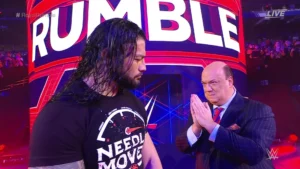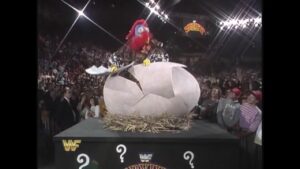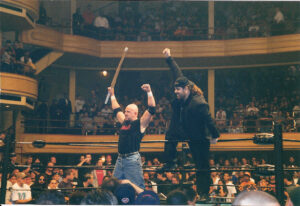Professional wrestling has a long history of employing professional athletes. And while countless amateur mat wrestlers have successfully transitioned to the world of pro wrestling, it’s arguably been the sport of football that has produced some of the world’s greatest stars. From high school to college football, many of the world’s greatest pro wrestlers got their sports pedigree from the gridiron – names like “Stone Cold” Steve Austin, Roman Reigns, The Rock, Big E, Paul “Mr. Wonderful” Orndorff, Ron Simmons, and many more, all turned to professional wrestling when their dreams of pro football came to an end. Even rarer that college football stars are those who actually made the jump to the NFL and due to either injury or continuous cuts, decided to turn to professional wrestling as another avenue. One of the first pro wrestling World Champions, Bronko Nagurski, was a 3x NFL Champion with the Chicago Bears (1932, 1933, 1943) as well as World Heavyweight Champion in 1937, wrestling into the 1960s. Since then, all kinds of former NFL players have made it to the world of wrestling and succeeded, such as Bruiser Brody (Washington), Vader (LA Rams), Wahoo McDaniel (who won the AFL Championship with Houston), Goldberg (Atlanta Falcons), and Moose (New England Patriots) are but a handful of examples of pro ballers who found success in the squared circle. But there is one name who seemed destined to become one of the 2000s greatest stars, but after an explosive debut and eventual landing in the WWE Universe, he walked away from the sport into almost self-imposed exile. This is the story of “The Alpha Male” Monty Brown.

From Saginaw, Michigan, Montaque “Monty” Brown played high school football with Bridgeport High School, then attended Ferris State University in his home state, where he became an All-American linebacker as a Ferris State Bulldog. Following his college days, he signed as a free agent with the Buffalo Bills, where he played from 1993 through 1995, playing in Super Bowl XXVIII in 1994. But despite playing in the NFL at the highest level, football wasn’t his first choice for a sport. “You know, when I was a kid growing up I didn’t have posters of football players on my wall,” Brown said in an interview with TNA back in 2004. “I had posters of wrestlers on my wall…I had Nikita Koloff on my wall. I had Dusty Rhodes. I had a bunch of guys on my walls. But there was one wall that was dedicated to Ric Flair. Nothing but Ric Flair posters on that wall.”

But circumstances made it tough for him to do what he truly loved, becoming a professional wrestler. “I played sports because there wasn’t any wrestling in junior high or high school for me,” he told TNA in 2004. “I excelled in your traditional sports back then, but I knew that it would one day lead me into wrestling one way or another. Like I said, as I grew up it stuck with me. I can remember the first Super Bowl we went to with Buffalo, all of the guys went out and did their own thing when it came to training, so I went to Main Event Fitness, a gym owned by Sting and Lex Luger at the time. I wanted to go there to see if I could meet any of the wrestlers. So it’s always been in me.” When his contract ran out with Buffalo after the 1995 season, he signed as a free agent with the New England Patriots, in part to be closer to the WWF’s headquarters in Stamford, Connecticut. No matter where his football career took him, his mind was always thinking about the next stage of his career, that of becoming a pro wrestler like his childhood heroes. Following an ankle injury during his first year with the Patriots, Brown realized it was time to step away from the gridiron and begin his journey into the world of pro wrestling.

He trained for the ring under two legends of the Michigan wrestling scene, one being then ECW star Sabu and the other being UFC legend Dan “The Beast” Severn. By 2001, he was ready for the ring, making his debut in the Michigan indies with Great Lakes Wrestling. It didn’t take long for him to make an impression. In less than a year, he was signed by Total Nonstop Action (TNA), an upstart promotion from Jerry & Jeff Jarrett that arose from the ashes of both WCW and ECW. TNA brought in several former WCW and ECW stars, but also brought in some of the top indie stars in the United States, while finding diamonds in the rough like “The Alpha Male” Monty Brown. He made his TNA debut on the third weekly pay-per-view episode, in an impressive win over Anthony Ingram, on July 3, 2002.
https://www.youtube.com/watch?v=8IRq8ugmZXM
But despite a strong start, including a shot at Ron “The Truth” Killing‘s NWA World’s Heavyweight Championship that August, Monty Brown departed TNA shortly after, following a loss to Sonny Siaki. “The reason was just that, basically, I think it was no one knew what to do with ‘The Alpha Male’,” he told Wrestling Epicenter in 2005. “No one knew what my character was about, who I was about, and at the time it was just a new thing for myself and the company, I had different things going on, they had different things going on…I didn’t get the opportunity to let the character flourish.” He returned to the independents, heading across the border to Windsor, Ontario, Canada where he would work for future TNA Executive Scott D’Amore at Border City Wrestling (BCW), as well as Lansing, Michigan’s All World Wrestling League (AWWL), and Detroit’s Insane Wrestling Federation (IWF) and Xtreme Intense Championship Wrestling (XICW).
https://www.youtube.com/watch?v=InxwCW8v9Oo
In March of 2004, he made his return to TNA with a new focus, determined to make sure the real Monty Brown would be seen this time. He returned to TNA in mid-March 2004, defeating Chris Vaughn in his re-debut, before battling one of his mentors, Sabu, to a no-contest two weeks later. After a brief feud with Sabu, he moved on to big victories over BG James (WWE’s Road Dogg), Sonny Siaki, Pat Kenney (Simon Diamond), and Ron Killings. By October, he had moved into the main event picture with TNA, competing in a #1 Contenders tournament where he lost in the final to Jeff Hardy. But he remained a top star with TNA and by the end of November, he challenged Jeff Jarrett (unsuccessfully) for the NWA World title.
https://www.youtube.com/watch?v=80vIiI07Ktc
In January of 2005, he regained his #1 Contendership again and once again faced Jeff Jarrett for the NWA World title at TNA Final Resolution 2005 (again in defeat), and then challenged once again at the inaugural Slammiversary in the King of the Mountain match for the NWA World’s Heavyweight Championship (won that night by Raven). The charismatic big man had lightning athleticism and had become a huge fan favorite in TNA and at both The Asylum and IMPACT Zone, with his “Pounce” that left many a TNA star bruised and battered.
https://www.youtube.com/watch?v=cid6UVsGmi0
In March of 2006, he had his final shot for the NWA World title, facing Christian Cage at TNA Final Resolution 2006, once again falling short. By May he failed to qualify for that year’s King of the Mountain Match, and by September, he had departed the company following the expiration of his contract. All through his TNA career, however, he continued to compete in the indies, appearing for the likes of Jersey All Pro Wrestling (JAPW), Maryland Championship Wrestling (now MCW Pro), and Michigan’s Prime Time Wrestling (PTW). It was with PTW that he would win the only championship title of his wrestling career, capturing the PTW Heavyweight Championship in October of 2005.
Following his departure from TNA, he entered negotiations with the company he’d dreamt of working for since his childhood and on November 16, 2006, WWE announced they had signed Monty Brown to a contract. But like most wrestlers who arrived in the WWF from another company, he found himself renamed, much like other stars like TNA’s Lance Hoyt (to Vance Archer), and Ring of Honor‘s Joey Matthews (to Joey Mercury) and Matt Sydal (to Evan Bourne). In January of 2007, he made his debut as part of WWE’s rebooted ECW brand, renamed as “The Alpha Male” Marquis Cor Von.
He won his WWECW debut against another former TNA star, Cassidy Riley, and went on to a string of televised wins over Wes Adams and Balls Mahoney, before joining the faction The New Breed (with Elijah Burke, Kevin Thorn, and Matt Striker), who began a feud against the ECW Originals. That April, Brown got his WrestleMania moment when The New Breed faced the Originals at WrestleMania 23 right in his own backyard in Detroit, Michigan.
As Marquis (then Marcus) Cor Von, he was pushed fast, first with The New Breed, then prepped for the main event scene in ECW, entering a tournament for the #1 Contendership for the ECW Heavyweight Championship. On June 19, 2007, he lost to CM Punk in the opening round on ECW on Sci Fi, and after that, departed the company unexpectedly for personal reasons. After three months away from WWE, he requested his release from the company, which he was granted that September and he promptly retired from the pro wrestling world. After only six months of time on WWE television – and nine in the company – he walked away from his childhood dream to take care of his family – his sister had passed away and he wanted to be there to help take care of her children. “I had to take some time away for a while on my own terms, but I kept a good rapport with the company and can come back at any time,” Brown told Michigan Live in 2009. “I’ve got a lot going and I had a lot going (before leaving the WWE).”
But sadly, the comeback never occurred. Monty Brown moved further and further from the wrestling spotlight, becoming a personal trainer in his hometown of Saginaw, Michigan, watching his old high school football team play. He made his return to the wrestling bubble in 2019, when he began attending both WWE and IMPACT tapings, catching up with old friends. The near 50-year old still looked to be in prime physical shape.

Even as recent as this past February, IMPACT kept the tease alive of a Monty Brown return, when current IMPACT star Moose began challenging Brown to a comeback match at IMPACT’s planned TNA special over WrestleMania Week, but the former “Alpha Male” refused to take the bait. “Monty Brown is someone that I’ve called out several times but I think Monty Brown is scared of Moose. I think he’s scared,” Moose told WrestleZone this past March, “he knows what Moose would do to him. It’s the same thing that RVD, Rhino, Ken Shamrock, and whoever I wrestle at ‘There’s No Place Like Home’. …I take that back—I don’t think Monty Brown is scared, I think he’s a smart man.”
But if you’re still hoping out that the now 50-year old Monty Brown is working on a comeback, to either WWE or IMPACT Wrestling, you may as well give up now. According to Fightful Select this week, Brown has no desire to return to active duty in the world of professional wrestling. Various companies, including IMPACT Wrestling, have reached out to Brown about a return but have come up empty-handed – although he did return briefly for a charity event featuring his old WWE buddy Kevin Thorn. But it was purely for an appearance – Brown refused to enter the ring. And thus the legend of Monty Brown remains intact.
https://www.youtube.com/watch?v=K-lShwkn7Nc
In both TNA/IMPACT Wrestling and WWE’s ECW, Monty Brown was indeed “The Alpha Male”. An outstanding physical specimen of power and agility, who had all the charisma in the world to be either company’s top African-American Superstar in a time when neither company truly had one. In November of 2006, just two months removed from Brown’s departure, Bobby Lashley was sent to ECW from SmackDown, and in December of that year, at December to Dismember, Lashley defeated The Big Show for the ECW Heavyweight Championship. Was this a position that Marcus Cor Von could have had?
Speaking of Lashley, he would head to TNA in 2009, where he would go on to become a 4x TNA World Heavyweight Champion. Could “The Alpha Male” have seen the same success had he stayed with the company in 2005? Hard to say. But Lashley seemed to become the African-American superstar that both companies had been searching for and seemingly had been pushing Brown towards before his sudden departures from either company. Was his family the sole reason he left professional wrestling for good in September of 2006? Or was there something more sinister backstage that soured him on his childhood dreams?
https://www.youtube.com/watch?v=L48vn_myhiI
Monty Brown rarely talks to the media anymore and when he does, it’s rarely about his wrestling days. It’s simply a part of his life he’s moved on from. But as #ForTheCulture began trending earlier this year and a rise in awareness of African-American wrestlers past, present, and future becomes a movement in pro wrestling in America, the name of Monty Brown has continued to rise as an inspiration of greatness never realized, of a man that should have received his just desserts far quicker than either of his major employers seemed to catch on to. The “one who got away” before he could achieve the superstardom that he deserved.
Stay tuned to the Last Word on Pro Wrestling for more on this and other stories from around the world of wrestling, as they develop. You can always count on LWOPW to be on top of the major news in the wrestling world, as well as to provide you with analysis, previews, videos, interviews, and editorials on the wrestling world. You can watch much of Monty Brown’s TNA run at IMPACT Plus service.






